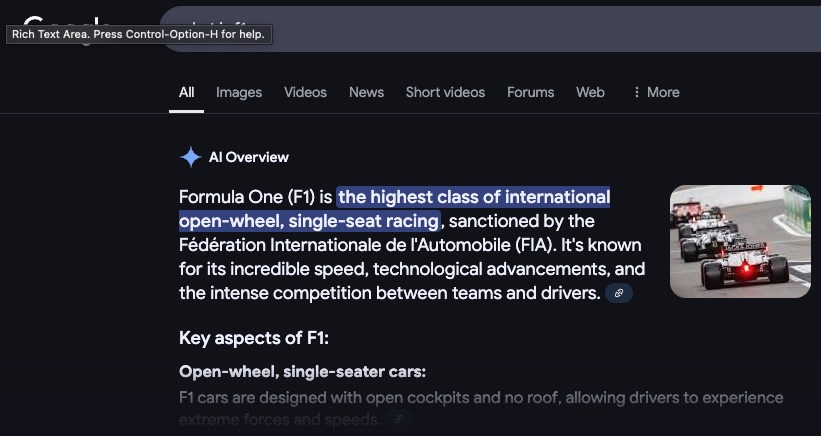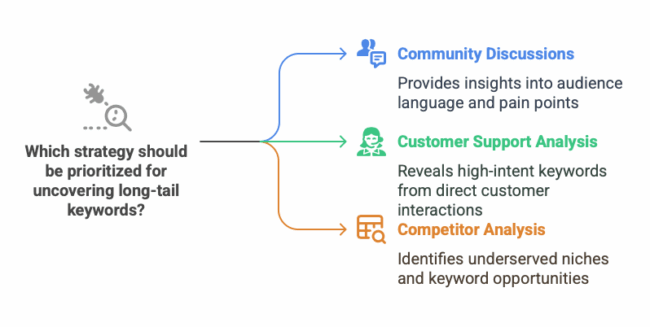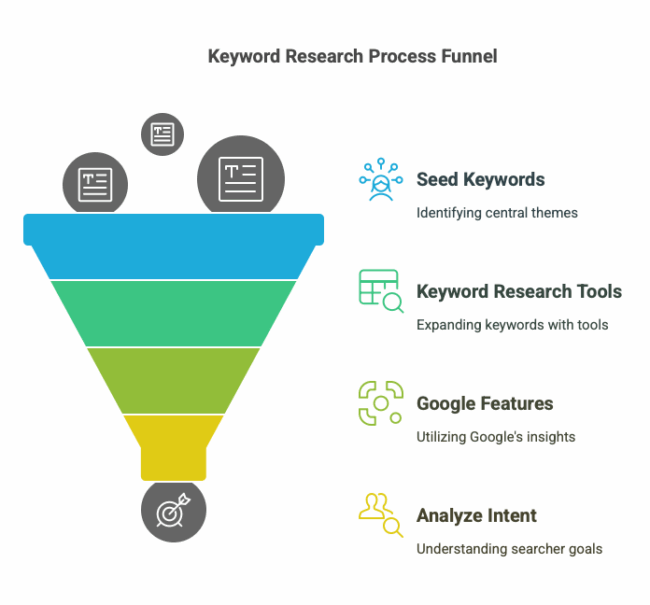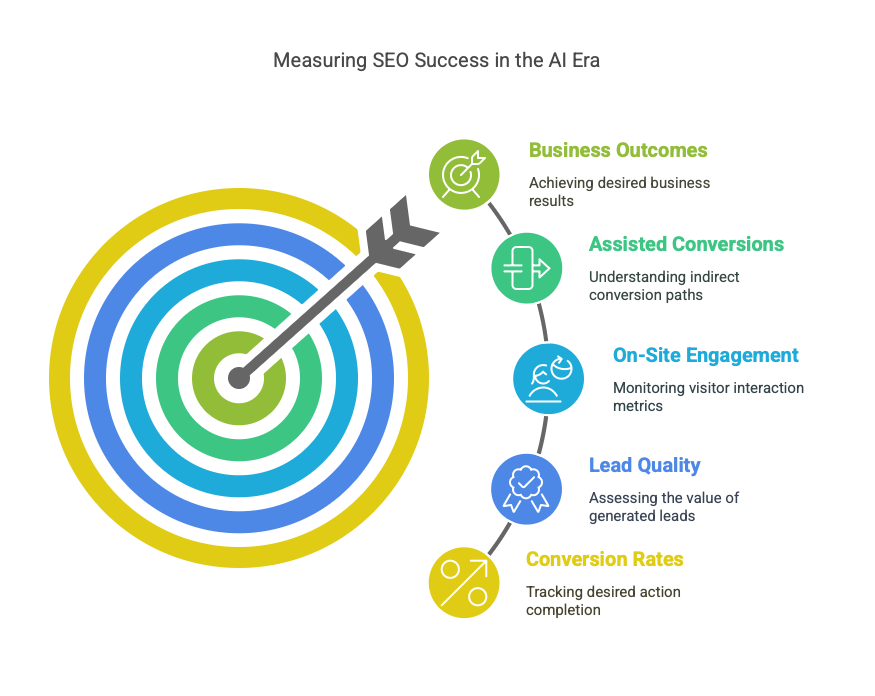
The digital search landscape is undergoing a seismic shift. Google’s AI Overviews (AIOs), the AI-generated summaries appearing at the top of many search results pages (SERPs), are rapidly changing how users find information and interact with content. As of early 2025, AIOs were appearing for over 10% of US desktop keywords, a figure that surged significantly following Google’s algorithm updates. Some studies even report AIOs appearing in over 40% of search results analyzed. These summaries, designed to provide quick, synthesized answers, are fundamentally altering the dynamics of search engine optimization (SEO). For bloggers, small business owners, and SEO professionals, understanding this change and adapting strategy is no longer optional—it’s critical for survival and growth. This post explores the impact of AIOs and outlines why a smarter long-tail keyword strategy is your most potent response in this new era.
Understanding the AIO Effect on Blog Traffic
The arrival of AI Overviews presents a double-edged sword for blog traffic. On one side, there’s the undeniable challenge of reduced clicks. AIOs often provide comprehensive answers directly within the SERP, satisfying user queries without needing them to click through to a website. This phenomenon, known as “zero-click searches,” existed before AIOs (think Featured Snippets and Knowledge Panels), but AIOs significantly amplify it. Studies have shown sharp declines in organic click-through rates (CTRs) for queries where AIOs are present, with some reports indicating CTRs halving or dropping even more dramatically. For instance, one analysis saw organic CTR fall from 1.41% to 0.64% year-over-year when an AIO appeared. This is compounded by the visual displacement; AIOs occupy prime SERP real estate, often pushing traditional organic results below the fold, especially on mobile devices.
However, the picture isn’t entirely bleak. Appearing as a cited source within an AI Overview offers a new form of visibility and brand awareness. While overall clicks might decrease, Google executives argue that clicks originating from AIOs are of “higher quality”. The logic is that users who click through after seeing a summary have a stronger intent and are less likely to immediately bounce, potentially spending more time on the site. Some studies support this, noting that clicks generated through AIOs can be more intentional and targeted, and specific research on B2B buyers found a high percentage clicking on AIO citations for fact-checking. Furthermore, being cited can sometimes lead to increased CTR compared to not being cited, and pages ranking outside the top 10 now have a better chance of being cited than before recent updates.
The impact also varies significantly. AIOs appear more frequently for informational queries (though their presence in transactional searches is growing), question-based searches, and initially dominated industries like healthcare and education, but saw dramatic spikes in sectors like travel, entertainment, and restaurants following core updates. CTR impact also differs across industries.
This complex reality forces a crucial shift in perspective. Simply achieving a top 10 organic ranking no longer guarantees substantial traffic. The traditional definition of SEO success is expanding to include visibility within the AIO itself. This doesn’t always mean a direct click, but the brand exposure and potential for highly qualified traffic make AIO citation a valuable goal. The simultaneous decline in both organic and paid CTRs hints at a broader change in user behavior. Users might be getting answers faster from AIOs or other AI tools, becoming more selective before clicking any link. This environment demands that every potential click offers a clear, compelling value proposition right from the SERP.
Long-Tail Keywords: Your Strategic Advantage
In this evolving search landscape, long-tail keywords emerge as a powerful strategic advantage. These are longer, more specific search phrases, typically consisting of three or more words, standing in contrast to broad, high-volume “head” terms. For instance, instead of targeting “WordPress plugin,” a long-tail approach might focus on “AI content generation plugin for WordPress.” Similarly, rather than “SEO tools,” an SEO professional might target “SEO workflow automation for multiple client sites.”
The benefits of prioritizing long-tail keywords are now more pronounced than ever:
- Lower Competition: By their very nature, long-tail keywords are more specific, meaning fewer websites are directly competing for them. This significantly lowers the barrier to entry for ranking, making it a viable strategy for smaller blogs, niche businesses, or websites without the massive domain authority needed to compete for head terms. Research indicates that keywords triggering AIOs often have lower keyword difficulty scores, aligning well with this strategy.
- Higher Specificity & Conversion Rates: Searchers using long-tail keywords typically have a much clearer idea of what they are looking for. They are often further along the buyer’s journey, moving from general research towards a decision. This specificity translates into attracting highly qualified traffic – visitors who are more likely to find your content directly relevant to their needs. Consequently, long-tail keywords boast significantly higher conversion rates compared to generic terms. Estimates vary, but sources suggest conversion rates can be 2.5 times higher, 3-5% higher in paid search, or even average around 36%. This resonates with Google’s assertion that AIO clicks are “higher quality” – long-tail searches inherently attract users with stronger intent.
- Strong Alignment with AIO Triggers: This is perhaps the most critical advantage in the current climate. AI Overviews are frequently generated in response to complex, conversational, multi-intent, or specific question-based queries. Long-tail keywords naturally mirror this structure and style. Studies show AIOs are triggered more often by long-tail keywords (around 65% in one study) and question formats (around 85% in the same study). The average word count for queries triggering AIOs is also increasing, reflecting more conversational search patterns. By optimizing for long-tail keywords, you are directly creating content that addresses the types of inputs most likely to generate an AI Overview.
 The strategic implication is clear: long-tail keywords are transitioning from being merely a tactic for finding niche traffic to becoming a primary lever for achieving relevance and potential citation within the AIO-dominated SERP, especially for complex informational searches. Because AIOs excel at synthesizing answers for these detailed queries, and long-tails represent those queries, aligning your content with long-tails means aligning with the very mechanism driving AIO generation.
The strategic implication is clear: long-tail keywords are transitioning from being merely a tactic for finding niche traffic to becoming a primary lever for achieving relevance and potential citation within the AIO-dominated SERP, especially for complex informational searches. Because AIOs excel at synthesizing answers for these detailed queries, and long-tails represent those queries, aligning your content with long-tails means aligning with the very mechanism driving AIO generation.
Furthermore, the superior conversion rate of long-tail traffic gains heightened importance in an era potentially marked by lower overall click volume due to zero-click searches. With fewer total visitors potentially arriving from search, each visitor becomes more valuable. Attracting users via high-converting long-tail keywords means that even with reduced traffic, conversions and bottom-line business impact can be maintained or even increased. The return on investment for optimizing these specific terms may now significantly outweigh chasing high-volume, low-conversion head terms.
How to Find Long-Tail Keywords That Drive Results
Identifying the right long-tail keywords is crucial. It’s not just about length; it’s about relevance, searcher intent, and potential business value. Here’s a systematic approach:
Step 1: Start with Broad Topics (Seed Keywords)
Begin by brainstorming the core themes central to your niche and relevant to your target audience. For BlogCopilot users, these might include “blogging,” “content creation,” “AI writing tools,” “WordPress SEO,” “increasing blog traffic,” “automated article generation,” or “SEO workflow”. These seed keywords form the foundation for deeper exploration.
Step 2: Use Keyword Research Tools
Leverage established SEO tools like Semrush or Ahrefs to expand on your seed keywords. Utilize features such as Semrush’s Keyword Magic Tool or Ahrefs’ Keywords Explorer and Content Gap analysis. Critically, apply filters:
- Length: Focus on phrases with 3 or more words.
- Difficulty: Target keywords with low to medium difficulty scores. While thresholds vary, aiming for a Keyword Difficulty (KD) below 20 is a reasonable starting point, as AIO-triggering keywords often fall in this range.
- Volume: Don’t dismiss keywords just because they have low search volume. Even terms showing 0-10 searches per month in tools can drive valuable, targeted traffic if the intent is right.
Step 3: Utilize Google’s Own Features (Free Methods)
Google itself is an invaluable resource for uncovering how people actually search:
- Google Autocomplete: Start typing your seed keywords and related phrases into the Google search bar. Pay close attention to the predictions that appear – these are based on real user searches. Experiment by adding letters (a, b, c…) or using the underscore (_) as a wildcard to generate more variations.
- People Also Ask (PAA): Look for the “People Also Ask” boxes within the SERPs. These sections explicitly list related questions that users are searching for, often representing excellent long-tail keyword opportunities.
- Related Searches: Scroll to the bottom of the search results page. The “Related searches” list provides further long-tail variations based on your initial query.
Step 4: Analyze Intent (Crucial Step)
Understanding why someone is searching is paramount. Simply finding a long-tail keyword isn’t enough; you must align your content with the searcher’s underlying goal. The main types of search intent are:
- Informational: Seeking information, answers, how-tos (e.g., “how does AI generate blog posts?”).
- Navigational: Looking for a specific website or brand (e.g., “BlogCopilot login”).
- Commercial Investigation: Researching before a potential purchase, comparing options (e.g., “best AI writing plugin for WordPress,” “BlogCopilot vs competitor”).
- Transactional: Ready to buy or take a specific action (e.g., “buy BlogCopilot plugin,” “BlogCopilot pricing”).
Analyze the SERP for your target keyword. What types of pages are ranking? Are they blog posts, tutorials, product pages, review sites, forums? This reveals Google’s understanding of the dominant intent for that query. Prioritize keywords whose intent aligns with your business objectives. For a blog aimed at attracting BlogCopilot users, informational keywords addressing user pain points (e.g., “how to save time writing blog posts”) or commercial keywords comparing solutions are likely high priorities.
Table: Understanding Keyword Modifiers and Search Intent
| Modifier Example | Likely Intent |
| how to, what is, guide | Informational |
| tutorial, why, explain | Informational |
| best, top, review, vs | Commercial Investigation |
| compare, alternative | Commercial Investigation |
| buy, price, cost, deal | Transactional |
| discount, coupon, order | Transactional |
| [brand name], login | Navigational |
| [brand] support | Navigational |
Actionable Tip Box: 3 Overlooked Sources for High-Intent Long-Tail Keywords
- Forum & Community Discussions: Dive into relevant subreddits (like r/SEO, r/Wordpress, r/blogging), Quora threads, and niche online communities. Listen to the exact language your target audience uses to describe their problems and ask questions. These platforms are goldmines for uncovering specific pain points and naturally phrased long-tail queries often missed by traditional tools.
- Customer Support Logs & Sales Feedback: Analyze your own customer interactions – support tickets, live chat transcripts, sales call notes, onboarding feedback. What questions consistently arise? What challenges do users face? These direct inputs represent high-intent, problem/solution-aware keywords that indicate a readiness for your solution.
- Competitor Deep Dive (Beyond Keywords): Don’t just look at the keywords competitors rank for. Examine customer reviews of their products on platforms like G2, Capterra, or WordPress plugin directories. Analyze their help documentation, FAQs, and community forums. What problems are their customers encountering? What specific features or use cases are frequently discussed? This intelligence can reveal underserved niches and keyword opportunities.

Effectively researching long-tail keywords in the age of AI Overviews demands moving beyond surface-level metrics. While tools provide essential data on volume and difficulty, understanding the questions, context, and nuances behind searches is increasingly vital. AIOs are often triggered by these complex, conversational queries. Qualitative sources like forums and customer feedback directly capture this nuance in users’ natural language, providing a richer foundation for targeting keywords likely to align with AIO generation when combined with quantitative tool data.

Furthermore, prioritizing search intent takes on heightened importance because AIOs strive to directly satisfy that intent within the SERP. Creating content for a long-tail keyword without accurately matching the dominant intent is likely a wasted effort. If an AIO provides the answer type the user sought (e.g., a definition for an informational query), users are far less likely to click on a misaligned result (e.g., a product page) that might rank below it. Accurate intent matching is therefore crucial not only to be considered relevant by the AI systems generating the overview but also to capture the attention of users who scroll past it.
Crafting Content for Both Humans and AI Overviews
Once you’ve identified promising long-tail keywords, the next step is creating content that resonates with both human readers and the AI systems powering AIOs. The good news is that these goals largely overlap.
Foundation: High-Quality, Valuable Content
The bedrock remains unchanged: create genuinely useful, insightful, and comprehensive content that addresses the searcher’s needs. AI Overviews tend to synthesize information from sources perceived as credible and authoritative. Thin, superficial, or inaccurate content is unlikely to be featured.
Emphasize E-E-A-T
Google’s quality guidelines emphasize Experience, Expertise, Authoritativeness, and Trustworthiness (E-E-A-T). Demonstrating these qualities is crucial for earning trust from both users and Google’s AI, which favors credible sources. Strategies include:
- Showcasing author expertise through detailed bios and credentials.
- Citing reputable external sources and data.
- Including original research, case studies, or unique data points.
- Sharing first-hand experiences where relevant.
- Providing clear contact information and ensuring website security (HTTPS).
- Getting mentions or backlinks from other authoritative sites in your niche.
Structure for Readability and AI Parsing
Clear structure benefits both humans scanning for information and AI systems trying to understand and extract key points. Employ:
- Logical Headings: Use H1 for the main title and H2s, H3s, etc., for subtopics to create a clear hierarchy.
- Short Paragraphs: Keep paragraphs concise, ideally 2-3 sentences, for better readability and easier AI parsing.
- Lists: Use bulleted or numbered lists whenever possible to break down information. AI systems often pull list formats directly into Overviews.
- Semantic HTML & Schema: Use appropriate HTML tags (like <strong> for emphasis). Consider implementing Schema markup (like FAQPage, HowTo, Article schema) to provide explicit context about your content to search engines.
Directly Answer the Core Question
For content targeting a specific long-tail question, provide a clear and concise answer early in the article, often within the first few paragraphs. AI Overviews frequently look for direct answers to satisfy the immediate query.
Ensure Comprehensive Coverage and Build Topical Authority
Don’t stop at the primary question. Cover related subtopics, address nuances, and answer follow-up questions (use PAA insights here). Creating interconnected content clusters around core topics signals depth and topical authority to Google.
Use Conversational Language
Write in a natural, clear, and accessible style. Avoid unnecessary jargon or overly complex sentence structures. This aligns with the conversational nature of many long-tail queries that trigger AIOs.
Aim for Top 10 Organic Ranking
While AIOs change the visibility landscape, traditional SEO fundamentals remain vital. Many AIO sources are pulled from pages ranking in the top 10 organic results. Therefore, strong on-page optimization, technical SEO health, and acquiring quality backlinks are still necessary to increase your chances of being considered for an AIO citation.
Keep Content Fresh and Updated
Regularly review and update your content with the latest information, statistics, or developments. Freshness is a signal of relevance that both users and Google’s AI value.
Implement Strategic Internal Linking
Use internal links to connect related pieces of content within your site. This helps users discover more information, strengthens your topical authority, and assists search engines in understanding your site structure and the relationship between pages. Consider linking to a comprehensive guide on E-E-A-T principles or a BlogCopilot resource on structuring AI-generated content for maximum impact.
Optimizing content effectively in the AIO era necessitates a dual focus. You must satisfy the human user’s need for clear, comprehensive, and trustworthy information (achieved through E-E-A-T, direct answers, depth, and readability). Simultaneously, you must cater to the AI’s need for easily parsable, well-structured data (achieved through headings, lists, potentially schema). These two requirements are synergistic; improving structure for AI often enhances readability for humans, and demonstrating E-E-A-T for humans builds the trust signals AI relies on.
The consistent emphasis on E-E-A-T and topical authority also suggests a deeper shift. Becoming a recognized, authoritative source within your niche may be more impactful long-term than merely ranking for isolated keywords. AIOs synthesize information from multiple trusted sources, implying Google evaluates the overall credibility of a domain, not just individual pages. Building deep expertise and demonstrating it consistently through clustered, high-quality content is likely a more sustainable path to AIO visibility.
Tracking Performance in the New SERP
Measuring SEO success in the age of AI Overviews requires adapting your approach and looking beyond traditional metrics.
Monitor Target Keyword Rankings
Tracking your organic rankings for target long-tail keywords remains a foundational step. This provides a baseline understanding of your visibility in traditional results. Various SEO tools can automate this process.
Track CTR Changes (with Critical Caveats)
Google Search Console (GSC) is the primary tool for monitoring clicks, impressions, CTR, and average position. It’s essential to track CTR trends for key pages and queries, especially informational ones prone to AIOs. However, understanding GSC data in the AIO context requires awareness of significant limitations:
- No Direct AIO Tracking: GSC currently does not allow you to isolate or segment performance data specifically for clicks or impressions coming from links within an AI Overview. While these interactions are recorded, they are mixed with standard organic results data.
- Position Skewing: When an AI Overview appears (often in position 1), all URLs cited within that overview inherit that position in GSC reports. This can artificially inflate the average position for those URLs, masking their true organic rank further down the page.
Given these limitations, focus on correlation rather than direct causation. Use GSC’s date comparison features to see if CTR for specific pages or queries dropped noticeably after AIOs became common for those terms. You can enhance this analysis by using third-party SEO tools (like Semrush, Ahrefs, seoClarity, Authoritas, AWR) that track AIO presence for your keywords. Overlaying this AIO presence data with your GSC performance trends can provide a clearer, albeit still estimated, picture of the impact.
Shift Focus from Vanity Metrics
The changes brought by AIOs render many traditional vanity metrics less meaningful as sole indicators of SEO success. High impression counts for irrelevant terms, large volumes of low-intent traffic, or even top rankings for broad keywords might look good on a surface-level report but don’t necessarily translate to business value, especially if clicks are declining or not converting.
Prioritize Conversions and Lead Quality
Instead, focus measurement on metrics that directly reflect business outcomes:
- Conversion Rates: Track how effectively the organic traffic that does arrive converts into desired actions (e.g., free trial sign-ups for BlogCopilot, contact form submissions, downloads). Analyze this by landing page and potentially by the intent associated with the driving keywords.
- Lead Quality: Go beyond just counting leads (e.g., Marketing Qualified Leads – MQLs). Track how many leads progress through the funnel to become Sales Qualified Leads (SQLs) or paying customers. A smaller number of high-quality leads is more valuable than a flood of low-quality ones.
- On-Site Engagement: For visitors who click through, monitor metrics like time on page, pages per session, and bounce rate. Higher engagement can sometimes indicate the “higher quality” traffic Google refers to.
- Assisted Conversions: Use analytics tools to understand how informational content discovered via long-tail searches contributes to conversions that happen later, perhaps through different channels.
Table: Measuring What Matters in the Age of AI Overviews
| Metric Type | Examples | Why It’s Less/More Meaningful Now |
| Vanity Metrics | Total Organic Traffic Volume | Less Meaningful: Can be inflated by low-intent traffic or decrease due to zero-clicks, masking true business impact. |
| Overall Impressions | Less Meaningful: High impressions without clicks or conversions don’t contribute to goals; AIOs can generate impressions without clicks. | |
| #1 Rankings for Broad Terms | Less Meaningful: High competition, low conversion rates, and AIOs may capture clicks even from #1 spot. | |
| Social Likes/Shares on Blog Posts | Less Meaningful: Poor proxy for SEO success; doesn’t directly correlate with conversions or revenue. | |
| Meaningful Metrics | Conversion Rate (by landing page/intent) | More Meaningful: Directly measures the effectiveness of traffic in achieving business goals; vital when overall traffic may decrease. |
| Lead Quality Score / MQL-to-Customer Rate | More Meaningful: Focuses on leads that actually drive revenue, filtering out low-intent traffic. | |
| Customer Lifetime Value (CLV) from Organic Acquisition | More Meaningful: Tracks the long-term value generated by SEO efforts, aligning with overall business health. | |
| Assisted Conversions | More Meaningful: Shows the value of informational content in the user journey, even if it’s not the last touchpoint. | |
| Engagement Rate of Visitors (Time on Site, Pages/Session, Bounce Rate) | More Meaningful: Can indicate visitor quality and content relevance for those who bypass AIOs. |
The current inability to isolate AIO performance within GSC creates an “attribution gap.” Marketers are forced to rely on correlating trends between GSC data and AIO presence data from third-party tools, or simply observing shifts before and after AIO rollouts. This uncertainty underscores the need to shift focus towards tracking what happens after the click – the tangible business outcomes like conversions and lead quality, which are undeniable indicators of value regardless of the precise path taken through the SERP.
If Google’s claim of “higher quality clicks” from AIOs holds true, it aligns perfectly with this necessary shift in measurement. It suggests a future where SEO success is judged less by the sheer volume of traffic acquired and more by the efficiency with which that traffic converts. This makes conversion rate optimization (CRO) an increasingly vital partner to SEO, working together to maximize the value derived from every precious click earned in the complex, AIO-influenced search environment.
BlogCopilot offers features to help navigate this new landscape, including robust keyword tracking and SEO analysis capabilities to inform your strategy and monitor visibility.
Conclusion: Adapting to the AI-Driven SERP
The integration of AI Overviews into Google Search represents a significant evolution, not an endpoint, for SEO. These AI-generated summaries are undeniably changing user behavior and traffic patterns, often leading to fewer direct clicks for traditional organic results but opening new avenues for visibility and attracting highly qualified visitors.

Adapting requires a strategic shift. Prioritizing a smart long-tail keyword strategy is paramount – these specific, lower-competition phrases align naturally with the complex queries that trigger AIOs and attract users with higher conversion intent. Content creation must double down on quality, demonstrating E-E-A-T while being meticulously structured for both human readability and AI parsing. Finally, performance tracking must evolve beyond vanity metrics, focusing laser-like on conversions, lead quality, and tangible business outcomes that prove SEO’s value in this new era.
This changing landscape isn’t a threat to be feared, but an opportunity for savvy bloggers, small business owners, and SEO professionals to differentiate themselves. By understanding the dynamics of AIOs and strategically adjusting keyword focus, content creation, and measurement, you can continue to drive meaningful results from search.
Ready to adapt your strategy? Unlock powerful long-tail keyword insights, streamline your AI-assisted content creation, and track your rankings in this new landscape with BlogCopilot. Try it today!
